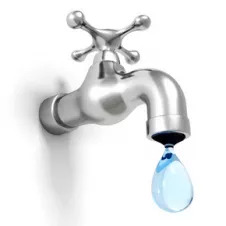 Here is some important information for homeowners to monitor their water usage. Every home has a water meter, generally located in your utility room. Once you locate your meter to check for a leak, using your meter, first make sure that no water is being used in your home. The meters have a low flow indicator (usually a little triangle on the top of the meter) if this is turning even slightly you have water flowing somewhere in your home.
Here is some important information for homeowners to monitor their water usage. Every home has a water meter, generally located in your utility room. Once you locate your meter to check for a leak, using your meter, first make sure that no water is being used in your home. The meters have a low flow indicator (usually a little triangle on the top of the meter) if this is turning even slightly you have water flowing somewhere in your home.
Generally the culprit is your toilets. If you have shut off valves on your toilets you can isolate each one and check to see if the meter has stopped turning. This will pin point which toilet is leaking. To check, simply lift your tank lid off and inspect water level. It may be running over the overflow tube—if so you may need to adjust your float so your toilet valve will shut the water supply off about 1” below the overflow tube. TIP! Add food coloring to your tank and wait several minutes. If you see colored water in your bowl, then the flapper located at the bottom of your tank is leaking and needs replaced.
Other pertinent areas to check are outside faucets, showers and sprinkler systems.
More Tips to Help You Save
- Take shorter showers. Long, hot showers can waste five to ten gallons every unneeded minute. Get a timer and time yourself. Install a low-flow shower head to reduce water use by 50% or more
- Take baths. A bath in a partially filled tub uses less water than all but the shortest showers.
- Turn off the water while you brush your teeth.
- Don’t let the water run constantly while you’re washing or rinsing dishes.
- Run the dishwasher only with a full load. The short cycle uses only 7 gallons.This can save 11-13 gallons per each cycle not run.
- Keep a pitcher of drinking water in the refrigerator. Running tap water to cool it off for drinking water is wasteful.
- Wash clothes with a full load. Wait until you have a full load. This can save about 35 gallons for each small load not run.
- Reduce lawn size. By reducing lawn size you can substantially reduce the amount of water used for landscape maintenance. Replace lawn area with native species of trees and shrubs. Consider alternatives to grass especially when you have steep slopes and shady areas.
- Use drought resistant grass species. Mixtures of grass species are used to get the most effective and long-lasting seasonal coverage. Fine fescues have low water needs and high drought tolerance. Generally an insect resistant mixture of grasses that includes a high percentage of fine fescues will ensure a drought resistant lawn.

- Water only when necessary. The two simple ways to tell if your lawn needs water are by the color and flexibility. If you walk on your lawn and leave a footprint or the color of your lawn turns blue/green the grass is not receiving enough water. Mature lawns that go brown in the summer are in a natural period of dormancy. They will green up when wetter cooler weather returns.
- Water slowly and deeply. Watering slowly and deeply will allow the water to be absorbed. You should water four to six inches deep, which means about one inch of water on the surface. By watering slowly and deeply you can save over 59 gallons a week in the summer.
- Water your lawn in the early morning. Early morning generally is better that dusk because it helps prevent the growth of fungus.
- Collect rainwater for landscaping needs. Use cisterns or rain barrels to capture rainwater from downspouts to use for newly planted vegetation. Use a lid, mesh fabric or add several drops of baby oil to prevent mosquitoes from breeding.
- Put a layer of mulch around the trees and plants. Mulch slows evaporation of moisture and discourages weed growth.
- Use a broom, not a hose, to clean driveways and sidewalks.
- Wash the car with a bucket and sponge. Using a bucket and sponge along with a hose with a shut-off valve can save 50 gallons or more per wash.
- Check for leaks in pipes, hoses, faucets, and couplings. Leaks outside the house may not seem as bad because they’re not as wasteful as leaks inside. Even the smallest drip from a worn washer can waste 20 or more gallons a day. Check frequently and keep them drip free.
For additional tips for things you can do around your home and garden to conserve water, follow the link below.

